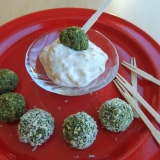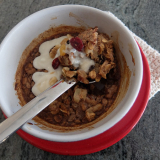I had my flu shot last week (and I hope you did too), so I’m feeling pretty smug as we move into cold and flu season. Last year I made it all the way to February before I came down with something that felt like ground glass in the throat, and perpetually lowered eyebrows in the head. At times like that, I need comfort, and lots of it.
I was a horrible eater as a child, subsisting on Lipton Chicken Noodle, hot dogs, and Velveeta Cheese. I must have driven my poor mother crazy – she had a skillful eye for nutrition, based on good farm upbringing and great common sense. Nevertheless, she could only clean up so much vomit before she found herself giving in to whatever worked for her picky, picky child. Even today, my preferred comfort foods are not always from the “eat more often” section of the food guide.
Just about everyone thinks of chicken soup when they want to “feed a cold”. It’s hot, and soothing, and steams the sinuses. It tastes good, and promises some nutritional reward. My first choice for “Invalid Food” is Egg Drop soup: easy to make, easy to eat, and a nice change from scrambled eggs for dinner. It fills you up without weighing you down.
It’s also a great “Solo Diner” quick dinner. The recipe sounds so simple: Chicken broth, an egg, green onions to garnish. Although there’s a bit more to it than that, you can go quick and easy, or a little slower and more complex. As usual, this is no “clip and save” recipe. Read it through, and make it your own.
Egg Drop Soup
The Broth (or The Stock, if you prefer)
Broth is made with meat: stock is made from bones. Also, while broth has had at least salt and pepper added, stock is technically unseasoned. The terms are used interchangeably, but that’s the difference, as far as I know. Consomme is clarified, concentrated, fortified stock. Boullion is a clear broth too, but not so complicated to make as consomme. Does that straighten everything out for you?
Start with good chicken broth. If you don’t make your own, you can choose from a variety of canned products. You can even use chicken base in powdered, cube or paste form if you’re desperate – I’m told (by Cook’s Illustrated) that the “Better than Boullion” bases are very good. (The batch we made with chicken base powder was certainly not our favorite.)

I like to use the 14 ounce can shown below on the left, as it makes a nice big bowl of soup with no leftovers. It’s “Ready to Serve” broth — no dilution required.
I prefer to season plain broth from scratch, but there are a number of shortcuts you can take. There are some pre-seasoned Oriental-flavored canned stocks out there, which you can keep in your pantry for Egg Drop Soup in an instant. A quick shake of no-salt onion/garlic/herb blend can stand in for fresh ingredients if your fridge is empty.

Whether you’re sick or just hungry, it’s good to take your Plain Jane broth and add a little life to it. Make a sort of “soup tea”, infusing a few flavorful elements into the broth. The traditional choices are green onion, ginger, and garlic, with a splash of rice wine vinegar for acidic brightness, and something sweet like Mirin (Chinese cooking wine) or a pinch of sugar to balance the flavors. Salt and white pepper complete the spectrum. How much you add is completely up to you, but for one can of my favorite broth (a little less than 2 cups) I would suggest, as a baseline:
- 2 green onions
- a piece of ginger the size of a double-thick loonie, smashed or cubed
- a biggish clove of garlic, crushed,
- a teaspoon of rice wine vinegar
- a teaspoon of Mirin

Of course, you don’t need to stop there. If you have lemongrass in your freezer left from the last time you made Bahn Mi burgers, chop some up and add it in. Dried mushrooms, or mushroom stems are good. If you want to add shitake mushrooms to your soup, put the tough stems in now, and add the tender sliced crowns later.
Cilantro or parsley stems are good too — throw in the stems and save the leaves for garnish. Soy sauce is very tasty, but your soup will lose its lovely pale quality, and you’re wandering into “Hot Pot” territory, flavor-wise. Don’t let that stop you – just be aware.

Kombu (sometimes called Konbu) is an Asian kelp I first encountered in a course on flavors I took at the CIA in Napa.
We tasted chicken stock in 4 variations: (1) unseasoned; (2) salted; (3) seasoned with salt and commercial MSG; and (4) seasoned with salt and simmered with Kombu.
It was a revelation in flavor to me. The appropriately salted broth was so much more delicious than the unseasoned broth, I vowed NEVER to send anything from the stove to the table without tasting and adjusting the seasoning. MSG really did make the stock taste much more “chicken-y”, and I didn’t die from it, although I know a few folks who claim it gives them anything from a runny nose to a headache.
The tastiest broth of all was the one that had been simmered with Kombu, which contains natural gultamates . It’s not hard to find if you have access to an Asian market, and it keeps in its dried form practically forever. I put a piece into every stock, every stew, every soup, every braise I make. It’s like a bay leaf – you don’t actually eat it, but it’s important to let it plays its role in flavoring a dish.

The Method:
Hold back a couple of tablespoons of your favorite chicken broth/stock (your 14.5 ounce can is about 1 ¾ cups), and heat up the rest to the boiling point. Add in every kind of flavor enhancing ingredient you intend to use. Let everything simmer for about 20 minutes. Strain out the solids, and return the broth to the pot. Taste it, and add anything you think it needs, like salt, or more pepper, or more vinegar. (I popped in my mushroom slices, for example.)




In order for the egg to produce lovely ribbons of tender goodness, the broth needs to be thickened a little. Mix 2 teaspoons of cornstarch into a slurry with your 2 Tablespoons of reserved cold broth, or water. Stir the slurry into your simmering soup, and keep stirring until the cloudiness changes to clarity. Continue to simmer for about 5 minutes to cook out any raw starchy flavor.


This is a good time to add in optional raw ingredients like sliced mushrooms, thinly sliced carrot, parsnip, daikon, or tiny florettes of broccoli, thinly sliced sweet peppers, asparagus even. Don’t go overboard – vegetable soup is a topic for another time. It’s just never a wrong thing to add a little vegetable to anything you’re cooking — well maybe not chocolate pudding….
Hold back on anything tender, like fresh chives, thinly sliced green onion, or fresh herbs — they go on last.
Beat an egg to homogeneity with a fork (ie, make sure the yolk and white are fully combined). If you need a parameter, you could count 100 strokes.


Turn the heat off under your broth. This is important. Otherwise, I wouldn’t have bothered with the caps and italics.
Give the broth a good stir. Now, STOP STIRRING. Drizzle in the beaten egg starting close to the edge of the pot, either allowing the current of the stirring to make it into streamers, or moving your drizzle over the surface of the soup to disperse the egg and prevent big clumps.
Still off the heat, pop the lid on the pot for a minute, so the egg can set.


While the egg is setting, decide if you need extra stuff in your soup. Pieces of cooked chicken, corn kernels, and sliced green onions seem to be pretty standard.
Put these garnishes in your serving soup bowl and give them a little microwave (30 seconds perhaps) so they’re not freezing cold.

Gently pour your soup into the bowl over the warmed additions. Now you can sprinkle on the green onions and/or herbs like parsley or cilantro or even basil. You could add a drop or two of Sesame Oil if you want to.
PS: If you have a cold, and everything you eat tastes like nothing, spike your soup with a squirt of Sriracha and a couple of teaspoons of sherry vinegar or red wine vinegar. Instant “Hot and Sour” soup! That’ll clear your sinuses!

















Leave A Comment